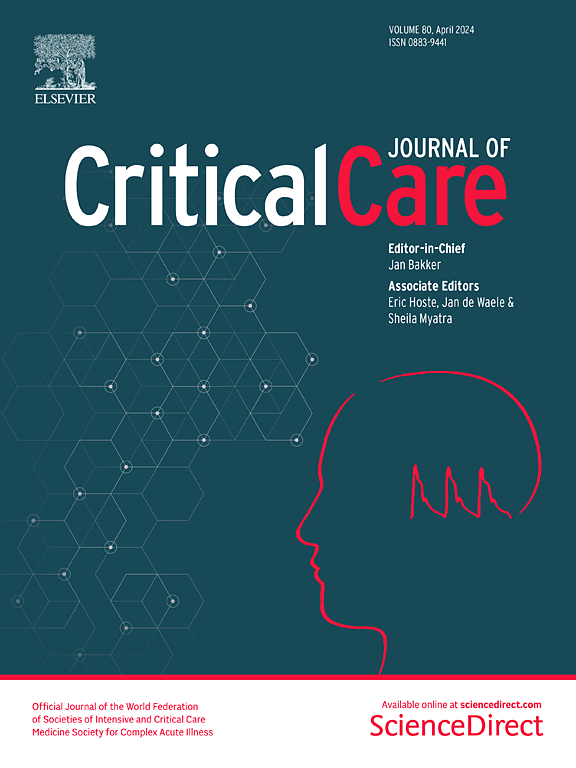High expression of L-GILZ transcript variant 1 (GILZ TV 1) is associated with increased 30-day sepsis mortality, and a high expression ratio possibly contraindicates hydrocortisone administration
IF 8.8
1区 医学
Q1 CRITICAL CARE MEDICINE
引用次数: 0
Abstract
Sepsis presents a challenge due to its complex immune responses, where balance between inflammation and anti-inflammation is critical for survival. Glucocorticoid-induced leucine zipper (GILZ) is key protein in achieving this balance, suppressing inflammation and mediating glucocorticoid response. This study aims to investigate GILZ transcript variants in sepsis patients and explore their potential for patient stratification and optimizing glucocorticoid therapy. Sepsis patients meeting the criteria outlined in Sepsis-3 were enrolled, and RNA was isolated from whole blood samples. Quantitative mRNA expression of GILZ transcript variants in both sepsis patient samples (n = 121) and the monocytic U937 cell line (n = 3), treated with hydrocortisone and lipopolysaccharides, was assessed using quantitative PCR (qPCR). Elevated expression of GILZ transcript variant 1 (GILZ TV 1) serves as a marker for heightened 30-day mortality in septic patients. Increased levels of GILZ TV 1 within the initial day of sepsis onset are associated with a 2.2-[95% CI 1.2–4.3] fold rise in mortality, escalating to an 8.5-[95% CI 2.0–36.4] fold increase by day eight. GILZ TV1 expression is enhanced by glucocorticoids in cell culture but remains unaffected by inflammatory stimuli such as LPS. In septic patients, GILZ TV 1 expression increases over the course of sepsis and in response to hydrocortisone treatment. Furthermore, a high expression ratio of transcript variant 1 relative to all GILZ mRNA TVs correlates with a 2.3-fold higher mortality rate in patients receiving hydrocortisone treatment. High expression of GILZ TV 1 is associated with a higher 30-day sepsis mortality rate. Moreover, a high expression ratio of GILZ TV 1 relative to all GILZ transcript variants is a parameter for identifying patient subgroups in which hydrocortisone may be contraindicated.L-GILZ 转录本变异体 1(GILZ TV 1)的高表达与 30 天败血症死亡率的增加有关,高表达率可能是氢化可的松用药的禁忌。
败血症具有复杂的免疫反应,炎症和抗炎之间的平衡对生存至关重要,因此败血症是一项挑战。糖皮质激素诱导的亮氨酸拉链(GILZ)是实现这种平衡的关键蛋白,它能抑制炎症并介导糖皮质激素反应。本研究旨在调查脓毒症患者的 GILZ 转录本变异,并探索其对患者分层和优化糖皮质激素治疗的潜力。研究人员招募了符合《败血症-3》标准的败血症患者,并从全血样本中分离出 RNA。使用定量 PCR(qPCR)技术评估了脓毒症患者样本(n = 121)和经氢化可的松和脂多糖处理的单核细胞 U937 细胞系(n = 3)中 GILZ 转录变体的 mRNA 定量表达。GILZ 转录本变体 1(GILZ TV 1)表达的升高是脓毒症患者 30 天死亡率升高的标志。脓毒症发病最初一天内 GILZ TV 1 水平的升高与死亡率上升 2.2-[95% CI 1.2-4.3]倍相关,到第八天,死亡率上升 8.5-[95% CI 2.0-36.4]倍。在细胞培养中,GILZ TV1 的表达受糖皮质激素的影响而增强,但不受 LPS 等炎症刺激的影响。在脓毒症患者中,GILZ TV1 的表达在脓毒症过程中会增加,并对氢化可的松治疗产生反应。此外,相对于所有 GILZ mRNA TVs,转录本变异体 1 的高表达率与接受氢化可的松治疗的患者死亡率高 2.3 倍相关。GILZ TV 1 的高表达与较高的 30 天败血症死亡率相关。此外,相对于所有 GILZ 转录本变体,GILZ TV 1 的高表达率是确定氢化可的松可能禁用的患者亚群的一个参数。
本文章由计算机程序翻译,如有差异,请以英文原文为准。
求助全文
约1分钟内获得全文
求助全文
来源期刊

Critical Care
医学-危重病医学
CiteScore
20.60
自引率
3.30%
发文量
348
审稿时长
1.5 months
期刊介绍:
Critical Care is an esteemed international medical journal that undergoes a rigorous peer-review process to maintain its high quality standards. Its primary objective is to enhance the healthcare services offered to critically ill patients. To achieve this, the journal focuses on gathering, exchanging, disseminating, and endorsing evidence-based information that is highly relevant to intensivists. By doing so, Critical Care seeks to provide a thorough and inclusive examination of the intensive care field.
 求助内容:
求助内容: 应助结果提醒方式:
应助结果提醒方式:


